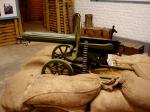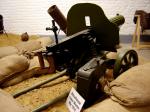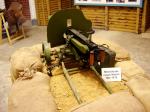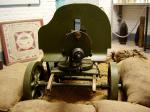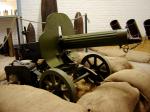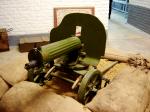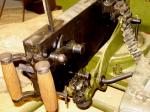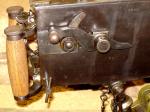La Maxim modèle 1910 ( Fort de Leveau ( Nord )France)
English Translation
Merci à Jean Marie pour les Photographies
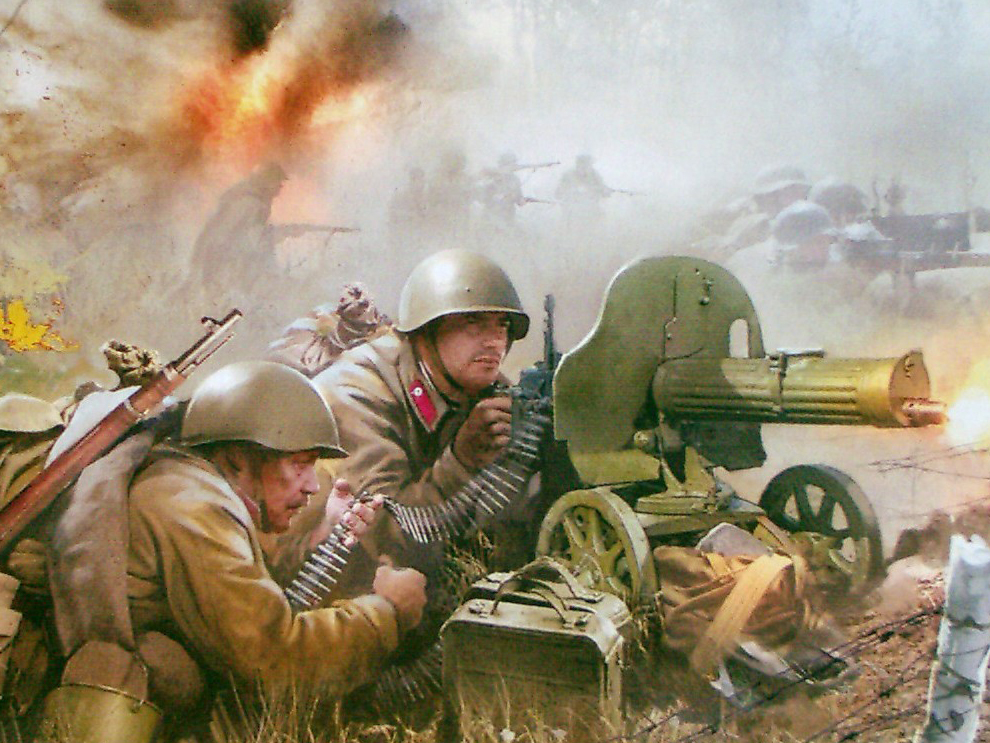 |
Histoire Voir ICI
History Click HERE
Elle fut mise au point par un Britannique d'origine américaine inventeur Sir Hiram Maxim en 1889 et elle fut rapidement adoptéepar l'Allemagne, la Grande-Bretagne , ainsi que l'US Navy
Les Russes l'ont aussi adopté en la simplifiant au maximun et en lui adjoignant un affut sur roue et un bouclier . Cela donne La Pulemyot Maxima Sokolov modèle de 1910, ou tout simplement PM 1910.
Elle avait un recul court ceux qui donnait l"impression se trouver lors du tir sur une locomotive à vapeur
Description
Cappable de débiter dix cartouches par seconde , l'arme aurait rapidement surchauffé si elle n'avait un système de refroidissement En effet pour refroidir elle possède dans le canon d'une reserve d'eau de 4 litres . Pour garantir le refroissiment on peut aussi en période hivernale envelopper le canon d'une bâche pouvant contenir de la neige
L'affut posséde de roue qui peuvent être rapidement remplacéese en hiver par des sky
Cette arme est rustique ce qui permet à la grande majorité des soldats russes de pouvoir la mettre en oeuvre . Tout es concu dans cette arme poiur être rapdiment nettoyé et démonté
Meme les bnades de munitions en toile sont utilisable facilement en hiver car elles sont cirées. Le necessaire de nettoyage tient dans une boite qui contiens solvants et lubrifiants
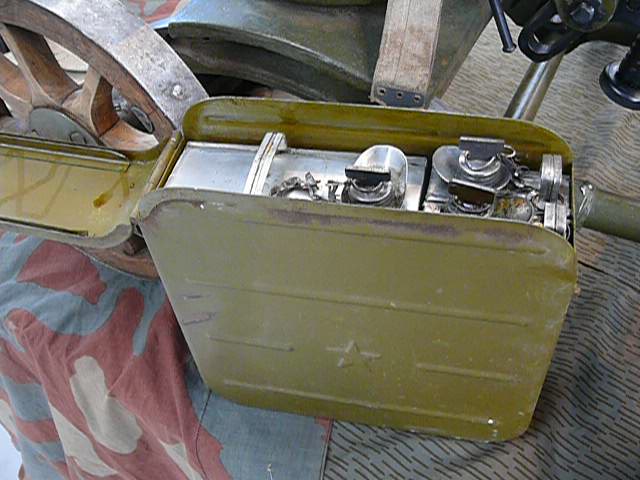 |
Ainsi entretenue elle possède une cadence de tir de 600 coups/ minute
Si elle est assez lourde c'est un gage de fiabilité et de stabilité lors des tirs
Utilisation
Cette arme a ccompagné les troupes russes lors des offensives de l'automne 1914 y compris chez les Cosaques (Carpates et Prusse orientale )
Elle fut aussi utilisé en extrème Orient dans des engagements souvent oubliés dans les montagnes de l'Arménie et sur la côte de la mer Baltique .
Lors de l'armisitce de Brest Littov en 1917 après avoir perdu plus de 3 millions de morts, il faut savoitr que la Maxim a renverser le court des combats à d'innombrables reprises .
Après la guerre , ils sont devenus l'une des armes emplématique de la Guerre Civile ( 1917-1922 )
C'est au cours de ce conflit que des Maxim furent montées sur des calèches de type tachankas , tirés par des chevaux rapides. Ces plates-formes sont donc les ancètres des automitrailleuses.
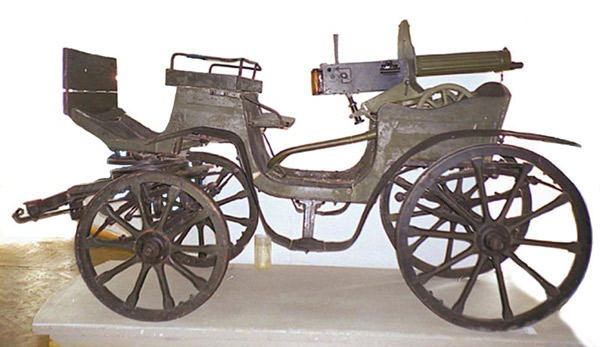 |
| tachanka |
Après la guerre civile , la Maxim PM 1910 restz en production et fut utilisé non seulement avec l'armée soviétique, mais aussi dans des pays comme la Finlande et la Pologne qui en avaient hérité des stocks importants
Elle fut aussi utilisé largement durant la Seconde Guerre mondiale par les Frontoviks soviétiques.
En 1945, le PM 1910 fut finalement été remplacé dans les unites de première ligne mais elle fut donnée comme aide militaire à des pays amis Aussi on continura à la voir dans les conflits d'indochine de Corée et du Vietnam , au Nicaragua et en Angola . Dernièrement, on a pu aussi la voir en en Syrie , l'Irak et la Libye. et aujourd'hui, plus de 130 ans après sa naissance les troupes américaines et de l'OTAN essueyent encore des tirs de cette arme en Afghanistan.
Invented by the American-born British inventor Sir Hiram Maxim in 1889, the machinegun that bears his name was the worldwide standard for automatic weapons by 1900. The militaries of Germany, Great Britain, as well as the US Navy among others had it in regular service. When the Russians adopted it, they greatly simplified the design to make it as soldier proof as possible. With the adoption of the short-wheeled mount and a steel plate shield to protect the gunner, the gun became known as the Pulemyot Maxima Sokolov Model of 1910, or simply PM 1910.The gun used distinctive and easily recognized short recoil and toggle locked mechanisms that gave users the feeling of holding onto a steam locomotive when fired. Rear spade grips served as handles while a solenoid button
Description
Between the grips, pushed by the thumbs, fired the gun. Capable of rattling off ten rounds of ammunition per second, the gun would overheat quickly. To keep it cool enough to fire continuously, a 4-liter water jacket was fitted around the 28.4-inch barrel. To keep this jacket from boiling empty from the red-hot barrel inside it, a water can, condenser collector, and tubes were supplied and an oversized cap on the jacket, about four inches in diameter, could be opened to pack the insides with snow in the winter. In a pinch the whole gun, wheels and all, could be attached to skis and pulled over the steppes when the snow got too deep.The weapon has a low profile to the ground, less than two feet, which leads to simplicity when firing from a prone position. Gun crews were also issued simple stands to elevate the guns if needed.Simplicity and durability were a rule in these guns. It must be remembered that conscripted Russian peasants fresh from the farms and with no mechanical background had to be trained to use and maintain these guns. The two spade grips concealed reservoirs that held lubricant and solvent. To apply these, you just unscrewed the top caps of the grips, to which were attached applicators inside the reservoirs. To clean the solid milled steel breechblock, an operator just opened the lid and lifted it up and out.Watertight 22-pound ribbed green metal cans held 250-round canvas belts of 7.62x54R ammunition. Even when many armies switched to metal links, the Russians retained these canvas belts because, when properly waxed, they were almost impervious to freezing and could be reused in the field without a linker.
 |
Another metal can held three modular cans of water, solvent, and lubricant. This kept the Maxim pumping out rounds non-stop at methodical rate of about 600-rounds per minute as long as the ammo held up.None of these heavy steel parts, thick ballistic shields, canvas belts, birch wheels, and other required accessories were very light. All told a fully equipped PM1910 could tip the scales at 170-pounds including ammunition, water, and solvents/lubricants.
Use
When the Cossacks and great waves of other infantrymen marched across the Carpathians and Eastern Prussia in 1914, the PM 1910 rolled along with them into World War 1. In thousands of often forgotten engagements, the Russian army used the Maxim guns to good effect from the mountains of Armenia to the coast of the Baltic Sea. While in the end of the first horrible world war, Russia signed a humiliating peace after losing more than 3-million dead, their Maxim guns managed to save the day on countless occasions.
After the war, they became one of the decisive weapons of the brutal Russian Civil War (1917-1922). It was during this conflict that maxims mounted on the back of peasant buckboard type carts known as tachankas, pulled by fast horses. These rigs were a direct precursor to modern vehicle-borne warfare.
 |
After the Civil War, PM 1910s remained both in production and in use with not only with the Soviet Army but also in countries such as Finland and Poland who had inherited large stocks of them. This put the heavy old bruiser inheavy combat once more during the Second World War where Soviet Frontoviks used the same guns in many cases that their fathers and grandfathers had before them.
By 1945 the PM 1910 was finally being replaced in front line service in the Motherland but was consequently given away as military aide to dozens of peace loving worker’s paradises. This kept the design popping up in the hands of fighters from North Vietnam and North Korea to Nicaragua, and Angola. Lately they have made cameo appearances in Syria, Iraq, and Libya. Today, more than 130 years after Mr Maxim’s initial concept and a good century past the improvements of Mr. Sokolov, US troops still occasionally come across these in weapons caches in Afghanistan.
Autre photoscope Other walk Around ICI HERE






